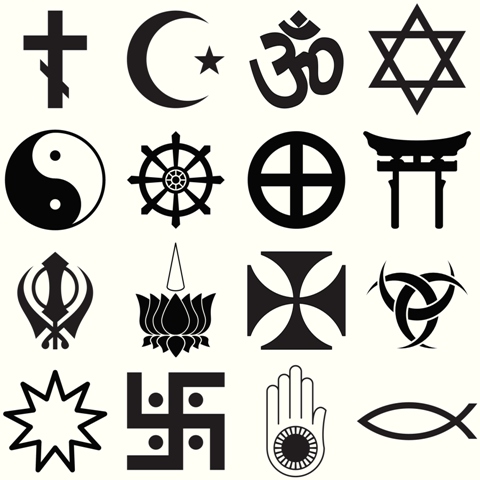The views expressed in our content reflect individual perspectives and do not represent the official views of the Baha'i Faith.
In Part I of this article, I explained how one quote from Abdu’l-Baha changed the course of my entire life, and led me to try to gain
“a thorough knowledge of those complex and transcendental realities pertaining to God, of the fundamental truths of Qur’ánic political and religious law, of the contents of the sacred Scriptures of other faiths….”
In the fall of 2007, a senior acquisitions editor at Praeger — an “imprint” (subsidiary) of the publisher ABC-CLIO — saw my “Religious Myths of America” course syllabus (Michigan State University, 2003–2004) online and invited me to submit a book proposal. So I submitted the proposal and wrote the book, which Praeger published in 2009 as Religious Myths and Visions of America: How Minority Faiths Redefined America’s World Role.
Explicitly in my classroom lectures and implicitly in the book on America, I would try to explain the difference between “ethnic religions” and “missionary religions” — and how a seeker of truth could narrow his or her spiritual search by knowing the difference.
I owe my understanding of the distinction between “ethnic religions” and “missionary religions” to my PhD advisor, the late Dr. Willard G. Oxtoby, Professor Emeritus of Comparative Religion at Trinity College and founding director of the graduate Centre for the Study of Religion, University of Toronto (where I received my PhD in the academic “Study of Religion in 1996).

Willard G. Oxtoby, Ph.D.
(1933–2003)
Thanks to Professor Oxtoby’s lectures, later I would first explain to my own students that many religions exist in the world today — some ancient in origin, others more recent. But we can make this long list of religions much smaller when we relate each of them to their parent faith in the broader categories of world religions.
For instance, we can simply group the 3,000 or so Protestant denominations registered in the United States today under the rubric of “Christianity.” This organizing procedure, if applied to all other religions today, reduces their number to around a dozen or so “world religions.”
Then we can further divide these dozen or so “world religions” into “ethnic religions” and “missionary religions.” “Ethnic religions” are those religions that one must be born into. Such religions, by and large, may accept outsiders into their respective communities (typically through “marrying” into the faith-community), but do not actively proselytize or seek converts.
“Missionary religions,” as a general rule, seek converts and therefore actively teach their Faith to others. In the process, they transcend cultural, ethnic, racial, and national boundaries. Let’s look at a “Quiz” question from Oxford University Press’ “companion” website to Professor Oxtoby’s textbook:
Which religion was both a missionary and a state religion from its start?
a) Christianity
b) Islam
c) Baha’i Faith
d) Buddhism
From the very question itself, Buddhism, Christianity, Islam and the Baha’i Faith are each identified as a “missionary religion.” So let’s group the following world religions according to these categories:
Ethnic Religions
1. Indigenous Religions
2. Hinduism
3. Jainism
4. Sikhism
5. Taoism
6. Confucianism
7. Shinto
8. Zoroastrianism
9. Judaism
Missionary Religions
1. Buddhism
2. Christianity
3. Islam
4. Baha’i Faith
Of course, these two categories contain exceptions. Some “ethnic” communities exist within otherwise “missionary religions” and “missionary” communities sometimes occur within the broader rubric of “ethnic religions.” (I don’t think that this particular distinction has been made in the scholarly literature, although I might be wrong.) For instance, “Transcendental Meditation” (TM), rooted in Hinduism, is a “missionary” movement within an otherwise “ethnic religion.”
So how does this distinction between “ethnic religions” and “missionary religions” relate to a seeker today who, in a quest for spiritual truth and wisdom, decides to investigate the various world religions?
The best way to narrow your spiritual quest for religious truth might be to focus your investigation on the “missionary religions” (i.e. Buddhism, Christianity, Islam and the Baha’i Faith), and perhaps “missionary ethnic religious movements” (such as “Transcendental Meditation”). That way, your search will center around the Faiths that actively encourage and welcome new believers from any background.
In the process of your investigation of world religions, this insight by Abdu’l-Baha may enlighten your thinking:
The first teaching is that man should investigate reality, … for the divine religions in their central and essential teaching are based upon unity, love and peace … Therefore, all souls should consider it incumbent upon them to investigate reality. Reality is one; and when found, it will unify all mankind. Reality is the love of God. Reality is the knowledge of God. Reality is justice. Reality is the oneness or solidarity of mankind. Reality is international peace. Reality is the knowledge of verities. Reality unifies humanity. In brief, His [Baha’u’llah’s] theme was that reality underlies all the great religious systems of the world. — Abdu’l-Baha, Promulgation of Universal Peace, p. 372.
Happy truth-seeking!
Read the previous article in the series: Narrowing Your Search – Part 1
©2013 by Christopher Buck.


















Comments
Sign in or create an account
Continue with Facebookor